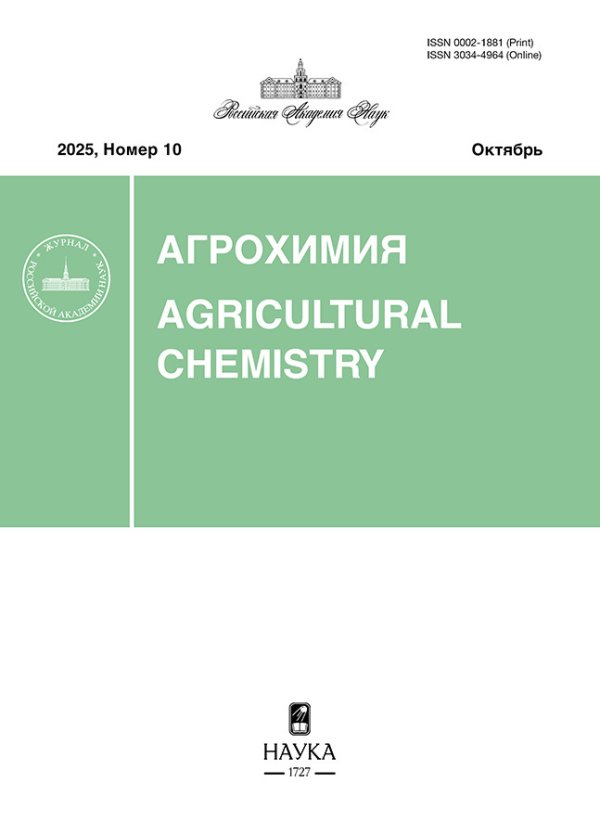Dynamics of Yield in the Long-Term Field Experiment of the Lyubertsy Experimental Field of the NIUIF. Message 1. Productivity in Plots
- Authors: Grakovsky V.G.1, Frid A.S.1
-
Affiliations:
- All-Russian Scientific Research Institute of Phytopathology
- Issue: No 3 (2025)
- Pages: 77-87
- Section: Research Methods
- URL: https://rjsvd.com/0002-1881/article/view/682832
- DOI: https://doi.org/10.31857/S0002188125030109
- EDN: https://elibrary.ru/UQHXVI
- ID: 682832
Cite item
Abstract
#E-mail: asfrid@mail.ru
Crop yields of 4-pole crop rotation for plots of long-term (42 years) field experiment on sod-podzolic sandy loamy soil of Lyubertsy experimental field were analyzed to study the effect of various forms of potash fertilizers. In order to identify the features of long-term yield dynamics and reduce the role of changes from year to year associated with crop differences, it is proposed to smooth out a long-term series of yields using the moving average method with a time window equal to the duration of rotation. As a result, clear yield changes with a cycle of 7–12 years were revealed, probably related to the cyclical nature of weather conditions. The long-term yield dynamics for plots corresponding to the control variant were similar to each other; the same was revealed for plots of the NP-variant. On the contrary, long-term dynamics for plots of all NPK variants were grouped by field repetitions, not by variants. Statistical differences between plots in terms of their yield were estimated using the t-criterion and the Wilcoxon criterion for conjugate samples. According to the series of differences between annual yields and their trend values, the errors of the average long-term yield indicators for plots were estimated, which made it possible to compare them with each other. The same was used for a 10-year period of studying the aftereffect of potash fertilizers. Long-term yield trends in plots in all cases turned out to be insignificant, but for plots of control and NP-variants, there was a tendency to decrease yields over time.
Keywords
Full Text
About the authors
V. G. Grakovsky
All-Russian Scientific Research Institute of Phytopathology
Author for correspondence.
Email: asfrid@mail.ru
Russian Federation, 5, Institute St., Bolshiye Vyazemy Village, Moscow Region, 143050
A. S. Frid
All-Russian Scientific Research Institute of Phytopathology
Email: asfrid@mail.ru
Russian Federation, 5, Institute St., Bolshiye Vyazemy Village, Moscow Region, 143050
References
- Глухих М.А., Калганова Т.С. Динамика обеспеченности чернозема выщелоченного тяжелосуглинстого северной лесостепи Южного Зауралья элементами питания // Вестн. АлтайГАУ. 2011. № 6(80). С. 5–8.
- Калганова Т.С. Динамика гумуса, азота и фосфора в черноземе выщелоченном северной лесостепи Зауралья // АПК России. 2015. Т. 72. № 1. С. 87–91.
- Ellmer F. Long-term field experiments as a research basis of sandy soil fertility // Изв. ТСХА. 2012. Вып. 3. С. 46–53.
- Прокошев В.В., Шугаров Ю.А., Жуков С.Н., Государева З.И. Результаты многолетних опытов по изучению эффективности калийных удобрений на дерново-подзолистой супесчаной почве // Агрохимическая эффективность новых форм минеральных удобрений. Тр. НИУИФ. Вып. 242. М., 1983. С. 35–49.
- Прокошев В.В., Государева З.И. Эффективность калийных удобрений на супесчаных почвах // Химия в сел. хоз-ве. 1980. № 9. С. 18–20.
- Фрид А.С. Рекомендации к анализу данных многолетних полевых опытов (проект) // Агрохимия. 2022. № 3. С. 81–93. doi: 10.31857/S0002188122030048
- Фрид А.С., Касатиков В.А., Борисочкина Т.И., Колчанова К.А., Никитина Н.С. Динамика агрохимических показателей почвы в многолетнем полевом опыте при внесении осадков сточных вод и извести // Агрохимия. 2022. № 9. С. 3–14. doi: 10.31857/S0002188122090058
- Фрид А.С., Касатиков В.А., Борисочкина Т.И., Колчанова К.А., Никитина Н.С. Влияние длительного применения осадков сточных вод и извести на валовое содержание и концентрацию подвижных форм тяжелых металлов в супесчаной дерново-подзолистой почве // Агрохимия. 2023. № 1. С. 83–96. doi: 10.31857/S0002188123010040
- Хлыстовский А.Д., Вехов П.А., Кулакова В.И. Эффективность длительного применения различных форм калийных удобрений на дерново-подзолистой тяжелосуглинистой почве // Агрохимическая эффективность новых форм минеральных удобрений. Тр. НИУИФ. Вып. 242. М., 1983. С. 17–34.
Supplementary files
















